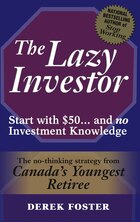Every since Derek Foster's Stop Working: Here's How You Can book hit store shelves in 2005, there have been critics of his early retirement strategy and questions surrounding its feasibility and the luck involved.
To follow-up on my previous post, The Lazy Investor - Part 1, in which I reviewed Foster's latest book, The Lazy Investor: Start with $50...and no Investment Knowledge, I thought it would be appropriate to present an interesting article I came across a few days ago that helps answer some of those questions.
Ellen Roseman's October 10th article in the Toronto Star provides some additional insights after her discussions with Foster.
What follows is an excerpt of Roseman's article, "Retiree, 34, helped by windfalls":
Last Thursday, he drove from his suburban Ottawa home – where he lives with a stay-at-home wife and four young children – and pulled out a stack of paper.
These were all his discount brokerage mailings going back to 1999. But since they weren't filed – or even unfolded – I wasn't going to sort through eight years' worth of transactions.
Meanwhile, the statements didn't tell the whole story. His investing career started in 1990, when he was 20. (He's now 37.)
Luckily, he'd prepared a summary. So, here's what I can tell you about Foster's strategy.
While he talks about saving and investing $200 a month over 12 years, that's just a baseline or minimum amount. He also added some windfall money (such as income tax refunds, GST credits, Christmas commissions while working at retail jobs and a pay-equity settlement).
He started with mutual funds, but now holds only dividend-paying stocks and income trusts. He's looking for companies whose products you use every day and whose shares you can hold forever.
Over time, he traded less and less. But in 1996, he borrowed money from his broker to buy Philip Morris, the U.S. tobacco manufacturer. Despite a $60,000 gain in a year, he sold the shares, fearing the company was vulnerable to lawsuits, and bought them back again later.
Still fond of leverage, he has more than $130,000 worth of stock bought on margin in his account (about 25 per cent of its current value).
He's been buying U.S. stocks that have become cheaper because of the falling U.S. dollar, such as Bank of America, Johnson & Johnson, Pfizer, Starbucks and Wal-Mart.
Why use borrowed money? Doesn't that make his strategy more risky? Well, Foster needs a tax break. His self-published books have brought in $150,000 in revenue he'd like to offset. (Interest paid on an investment loan is tax-deductible.)
And, as a self-described "control freak" who makes up his own mind, he's not afraid to take big stock positions. For example, he owns 1,000 Wal-Mart shares, now worth $45,000 (U.S.) and 700 J&J shares (worth $46,000).
Gutsy and confident, skeptical of conventional wisdom, Foster is not a typical investor. But he doesn't pretend to be. "Retiring at 34 is exceptional, as I state in my book," he says.
"However, this strategy is the surest way to early retirement without undue risk, and if readers follow this strategy and retire 10 to 15 years earlier than they thought, it's a success."





No comments:
Post a Comment